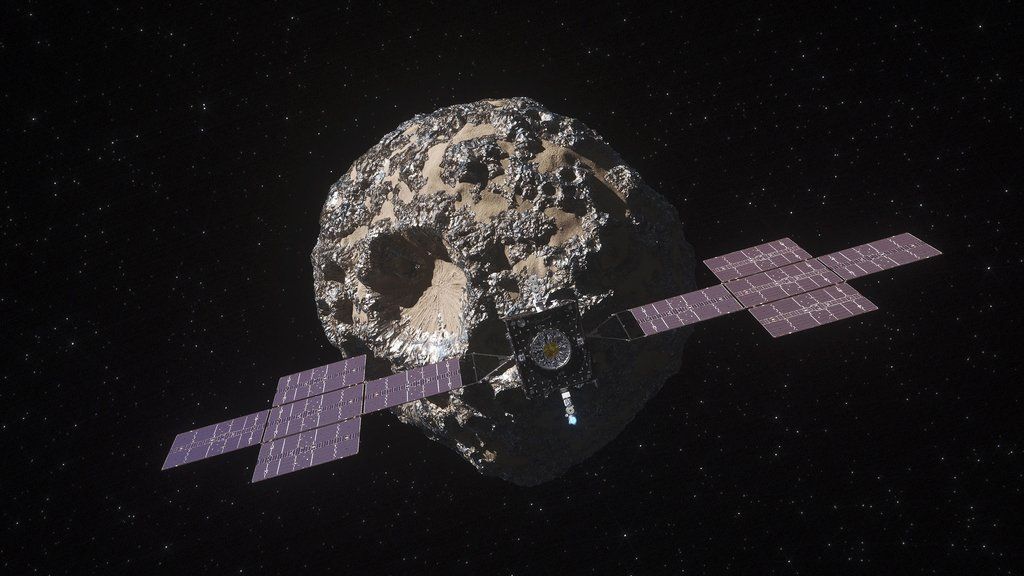NASA is preparing to launch its Psyche spacecraft on the first mission designed to study a metal-rich asteroid up close. The Psyche mission is set to blast off on Thursday (Oct. 12) from NASA’s Kennedy Space Center in Florida at 10:16 a.m. EDT (1416 GMT) atop a SpaceX Falcon Heavy rocket.
After traveling an estimated 2.2 billion miles (3.5 billion kilometers), the spacecraft will arrive at the asteroid 16 Psyche, which is located at the far edge of the main asteroid belt between Mars and Jupiter, in 2029.
Once the spacecraft is in place, mission scientists will study the metal asteroid, which is different from the rock- and ice-dominated bodies studied in situ in the past, to learn more about how the rocky planets of the solar system (Mercury, Venus, Earth and Mars) formed.
What’s so special about metal asteroid Psyche?
Discovered in 1852, Psyche is considered one of the most fascinating objects in the main asteroid belt, and scientists have only been able to study it at a distance. Scientists think the asteroid is composed of the exposed core of a planetesimal, a small body that formed during planet formation as gas and dust around a star collapsed in dense patches.
A planetesimal could eventually go on to gather more mass and thus become a planet. But Psyche is thought to have failed to reach planet status because it collided with other larger bodies as the solar system was forming around 4.5 billion years ago, possibly stripping the metal-rich asteroid of its outer rocky shell and exposing its iron-rich core.
That means that studying this 173-mile-wide (279 km), potato-shaped asteroid could not only help reveal more about the collisions that took place in the early solar system but also provide scientists with a proxy for the inaccessible iron core of our own planet.
Psyche seems to diverge from the solar system planets born from planetesimals. Whereas the rocks of the inner solar system planets are replete with iron oxides — chemical compounds of iron and oxygen atoms — Psyche lacks these compounds. If Psyche is indeed composed of material left over from the birth of the rocky planets, its existence could point to a different type of planetary formation that diverges from the mechanism that created Earth.
But even if Psyche turns out not to be an exposed planetesimal core, the asteroid is still very interesting to scientists because it could mean it belongs toa population of never-before-seen primordial solar system bodies.
What’s so special about NASA’s Psyche mission?
One of the most vital parts of the Psyche mission will be getting the spacecraft to this distant asteroid and then keeping it in place so its scientific instruments can do their jobs.
To do this, the spacecraft, which measures 16.1 by 7.1 by 7.8 feet (4.9 by 2.2 by 2.4 meters), will depend on a solar electric propulsion system that captures sunlight with its large solar arrays and then converts it to electric and magnetic fields. These fields accelerate charged atoms of the propellant xenon , which is commonly found in plasma televisions on Earth. These atoms, in the form of blue-glowing ionized gas, are then blasted out into space by the Psyche spacecraft’s four thrusters, providing the craft with propulsion that looks like something straight out of science fiction.
According to NASA, each of these four thrusters operates one at a time, providing a force equivalent to the weight of three quarters in your hand here on Earth — which, in the microgravity and frictionless environment of space, is enough to propel the spacecraft.
Even with these revolutionary “Hall-effect thrusters” — which, so far, have been used to get only as far as the moon — the spacecraft’s journey to the vicinity of Jupiter won’t be a ‘straight shot.” Instead, it will require a gravity-assisted slingshot maneuver around Mars in 2026, and Psyche will arrive at its metal-rich asteroid target in August 2029.
The spacecraft will then make orbits of the asteroid at a distance of around 430 miles (700 km), which will decrease as the mission proceeds. The spacecraft will use progressively closer orbital periods , or “regimes ,” to investigate different characteristics of the asteroid.
During its first orbital regime (A), lasting 56 days, the spacecraft will use its magnetometer to search Psyche for an ancient magnetic field, which would provide evidence that the asteroid was once a planetary body. As the spacecraft does this, its multispectral imager will assess the topography of Psyche’s surface. This will continue as the NASA orbiter draws closer to the asteroid, hopefully revealing more details of these characteristics, particularly during the next two orbital regimes (B1 and B2), which will last 192 days.
Moving even closer to the asteroid, during the 100-day orbital regime C, Psyche’s telecommunications system, which sends data to Earth and receives commands from ground control via radio waves, will be used to investigate the gravitational influence of the metal-rich asteroid. This could help better constrain its mass and density and thus the asteroid’s interior composition and structure.
During its 100-day orbital regime D, Psyche will employ its gamma-ray neutron spectrometer to get a better picture of the asteroid’s surface topology and investigate the chemical elements that are abundant on the asteroid’s surface.
The Psyche mission is the result of a collaboration among several institutions, including Arizona State University, which provided the spacecraft’s multispectral imager; NASA’s Jet Propulsion Laboratory, which is responsible for mission management, operations and navigation; Maxar Technologies, which provided the chassis for the solar electric propulsion system and other hardware; and NASA’s Launch Services Program at Kennedy Space Center, which acquired the SpaceX Falcon Heavy rocket for launch and will handle launch services.
You can watch the launch Thursday beginning at 9:30 a.m. EDT (1330 GMT) on NASA TV and directly on Space.com courtesy of NASA.

